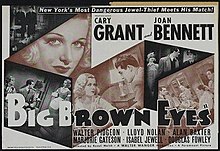| Big Brown Eyes | |
|---|---|
 Theatrical release poster | |
| Directed by | Raoul Walsh |
| Screenplay by | Bert Hanlon Raoul Walsh |
| Based on | "Hahsit Babe" "Big Brown Eyes" 1935 Liberty magazine stories by James Edward Grant |
| Produced by | Walter Wanger |
| Starring |
Cary Grant Joan Bennett Walter Pidgeon |
| Cinematography | George T. Clemens |
| Edited by | Robert L. Simpson |
| Music by | Gerard Carbonara |
Production company | |
| Distributed by | Paramount Pictures |
Release date |
|
Running time | 77 minutes |
| Country | United States |
| Language | English |
| Budget | $289,696 [1] |
| Box office | $359,009 [1] |
Big Brown Eyes is a 1936 American comedy crime film directed by Raoul Walsh and starring Cary Grant, Joan Bennett and Walter Pidgeon. [2] It was produced by Walter Wanger and distributed by Paramount Pictures.
Plot
Police officer Danny Barr is chasing jewel robbers. His girlfriend, Eve Fallon, is initially working as a manicurist, but quickly takes a job as a reporter assisting in the effort against the jewel thieves. Fallon and Barr become disgusted when one jewel gang member is acquitted after killing a baby in Central Park, and both leave their jobs. Soon thereafter, Fallon gets a lucky break while giving a manicure and the case is solved.
Cast
- Cary Grant as Det. Sgt. Danny Barr
- Joan Bennett as Eve Fallon
- Walter Pidgeon as Richard Morey
- Lloyd Nolan as Russ Cortig
- Alan Baxter as Cary Butler
- Marjorie Gateson as Mrs. Chesley Cole
- Isabel Jewell as Bessie Blair
- Douglas Fowley as Benjamin 'Benny' Battle
- Henry Brandon as Don Butler
- Joe Sawyer as Jack Scully
Reception
The film recorded a loss of $14,645. [1] Critics have regarded it as "disposable" [3] and "inconsequential" [4] with "shoddy writing and generally uninspired performances." [5]
Writing for The Spectator in 1936, Graham Greene gave the film a positive review, characterizing it as "a fast well-directed and quite unsentimental gangster film, pleasantly free from emotion". [6]
More recent writers have been kinder to the film. Grant biographer Scott Eyman called it an "unheralded gem in Grant's catalogue, a snappy comedy-drama [...] a cheerfully disreputable pre-Code film unaccountably made after the Code, with speedy cross-talk that prefigures His Girl Friday." [7] Writing for The New Yorker, Richard Brody hailed the film's "cocksure grifters and workaday wiseacres who dish out sharp-edged patter—none more than Grant and Bennett, whose gibing often resembles quasi- Beckettian doubletalk. Here, Grant offers early flashes of the brash, suave, and intricate antics on which his enduring comedic persona is based." [8]
References
- ^ a b c Bernstein, Matthew (1994). Walter Wagner: Hollywood Independent. University of California Press. p. 436. ISBN 978-0520081277.
- ^ Brody, Richard (February 10, 2015). "Movie of the Week: "Big Brown Eyes"". The New Yorker. Retrieved May 16, 2017.
- ^ Vineyard, David L. (August 8, 2009). "A Movie Review". mysteryfile.com. Retrieved May 16, 2017.
- ^ Kellow, Brian (November 26, 2004). The Bennetts: An Acting Family. University Press of Kentucky. p. 205. ISBN 0813123291.
- ^ N., F.S. (May 2, 1936). "At the Capitol". The New York Times. Retrieved May 16, 2017.
- ^ Greene, Graham (June 19, 1936). "Dangerous/Big Brown Eyes". The Spectator. (reprinted in: John Russel, Taylor, ed. (1980). The Pleasure Dome. Oxford University Press. pp. 82. ISBN 0192812866.)
- ^ Eyman, Scott (2020). Cary Grant: A Brilliant Disguise. Simon & Schuster. ISBN 978-1501192111.
- ^ "Big Brown Eyes". The New Yorker.
External links
- 1936 films
- 1930s American films
- 1930s crime comedy films
- 1930s English-language films
- 1936 comedy films
- American black-and-white films
- American crime comedy films
- American detective films
- Films based on short fiction
- Films directed by Raoul Walsh
- Films produced by Walter Wanger
- Films scored by Gerard Carbonara
- Films set in New York City
- Paramount Pictures films
- Ventriloquism
- English-language crime comedy films
- Crime comedy film stubs